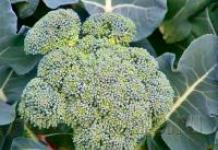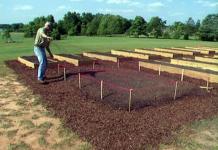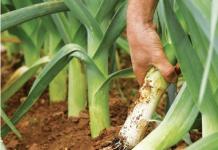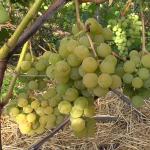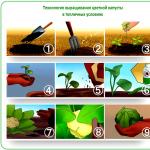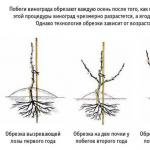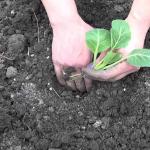In the old days, a peasant's garden was impossible to imagine without cabbage. So today, even on two acres, a couple of heads of this healthy and tasty vegetable will definitely grow. But in modern greenhouses today they grow not only white cabbage, but also no less useful Peking, and Chinese, and cauliflower, and Savoy, and Brussels sprouts, and even broccoli. This is because, although cabbage itself is a cold-resistant plant, it can still be destroyed by long-term low temperatures. That is why only a greenhouse can guarantee its good harvest. And cabbage cannot do without increased moisture, especially its seeds. But an overabundance, of course, can lead to the death of the roots. Therefore, in the cultivation of this particular vegetable, everything is good in moderation, and this measure is just the easiest to control indoors.
In the greenhouse for moisture-loving cabbage - just the same ideal conditions. That is why growing in it far from one dozen goals per season is within the power of even a novice summer resident. The main thing is to correctly calculate the timing of planting seeds, and growing cabbage in a greenhouse will be an easy and enjoyable experience.
Option # 1 - early cabbage
The most important thing is to choose the right variety of early cabbage. So, from the most well-proven ones we can name the following:
- "Dietmar early". This is an early ripening variety, which will give the first harvest already 50-70 days after planting the seedlings in the greenhouse.
- "Golden Hectare 1432". This variety has a period from planting seedlings to the first heads of cabbage - 105-129 days. This variety is distinguished by the resistance of heads to cracking, which in itself is important.
- "Number One K-206". If you use this variety, then about 100-125 days will pass from the appearance of the first shoots to heads of cabbage. But all heads of cabbage will ripen together, giving from 25 to 40 kg of yield for every 10 m 2. It is only important to remove everything on time - otherwise the heads of cabbage will have time to crack.
There are no special tricks for growing such cabbage, so we move on.
Option #2 - Chinese cabbage
Delicious and beautiful Beijing cabbage - early ripening. It is most convenient to grow it in seedlings. First of all, high humidity is needed for Beijing cabbage - 70-80%.
Also, in order to successfully grow Beijing cabbage in a greenhouse, it is important to maintain the optimal temperature regime. After all, this cabbage is a cold-resistant plant, and exceeding the temperature in the greenhouse by more than + 15-20 ° C will immediately lead to the formation of a flowering stem. And in general, a violation of the temperature regime is fraught with plant disease, which may simply not form a head.
Option #3 - Cauliflower
Growing cauliflower in a greenhouse is not difficult, although it is considered the most demanding - it is only important to ensure optimal temperature and humidity. So, if the temperature is too high and the humidity is low, then the cauliflower heads will lose their density and begin to crumble. That is why the soil for growing cauliflower must be well fertilized and moistened - these are indispensable conditions.

Cauliflower seedlings can be planted in greenhouses and greenhouses at the end of March. Portable greenhouses are best suited for this purpose, because the growing season of this plant is quite large. In any case, the most important thing is to harvest the cauliflower in time so that the plant heads do not have time to crumble.
Option #4 - white cabbage
The most difficult thing is to correctly grow seedlings of white cabbage. For this, a special biofuel greenhouse is most suitable, which can be used since March. And after that, the finished seedlings are transplanted into the greenhouse.
Growing seedlings
A good alternative to such a greenhouse is steam beds, which can be made by digging a pit 125 cm wide and 30 cm deep. Biofuel should be laid at the bottom, and sprinkled with a layer of earth on top. Finally, cover with foil. And the simplest shelters for growing seedlings are film, frame type. You can install them directly on the ridges in the spring. The main thing is that their height should not be less than 30 cm.
So, as soon as the soil in the greenhouse or under the shelter is warmed up to 18-20 ° C, the sowing itself can begin. For this, it is advisable to choose the darkest and largest seeds, soak them in water at 50 ° C for 20 minutes, quickly cool them by immersing them in cold water for 3 minutes, and dry them on a newspaper, scattering them in a very thin layer. It is also advisable to disinfect the seeds of white cabbage even before planting by treating them with a solution of nitrophoska.
After that, the seeds can be sown in a greenhouse, covering it with frames and throwing any warming material on top of it. The first shoots will already be on the 4th day, and the shelter for the day will need to be removed. But when the first true leaf appears, all seedlings must be picked, or at least thinned out. After that, it is important to raise the temperature in the greenhouse by 2-3°C and maintain it already within 10-12°C.

After the seedlings have a few leaves, you need to intensify watering - but without waterlogging. It is best to water the seedlings early in the morning. And after picking, you can start feeding cabbage by taking 20 g of nitrogen fertilizers, 10 g of potash fertilizer and 40 g of superphosphate in a bucket of water - this is all for one greenhouse frame. And the second time, the seedlings will need to be fed only with nitrogen fertilizer, taking 25-20 g per bucket of water. And, finally, before moving the seedlings to the greenhouse, it is desirable to feed it for the third time - 30 g of nitrogen fertilizer + 20 g of potassium + 20 g phosphorus + 1 bucket of water. If, by the way, fertilizers accidentally get on the leaves of plants, they must be washed off immediately with clean water.
Planting seedlings in a permanent place
And now, already a couple of days before the relocation of seedlings, greenhouses should be ventilated, leaving the frames open for the whole day and even at night, if the weather is good. And on the day of sampling, seedlings need to be well watered. Ideally, it should have at least 3 leaves in early varieties, 5 leaves in late varieties and a developed root system. It is not necessary to shake off the earth from the roots. And if it is possible to select seedlings, then preference should be given to one in which the stems are lilac-green in color, and not pale green in color - this is a sign of an underdeveloped root system that will not be accepted well in greenhouse soil. As a result, from one such frame you can get up to 600 seedlings.

The first watering of cabbage can be done only when the cabbage takes root in the greenhouse, but not earlier than 8 days.
Greenhouse cabbage care
By the way, special attention should be paid to the fertilizer of cabbage with potassium and nitrogen in the greenhouse - the formation of its head depends on this. Cannot stand white cabbage and shading - it needs a lot of light.
Interestingly, experienced gardeners advise sowing cabbage seeds for seedlings as early as mid-December, illuminating the seedlings with special lighting. A heated greenhouse should be planted in a permanent place only at the age of 55-60 days. Moreover, nitrogen nutrition will need to be applied only in the first month, and then only potassium and phosphorus.
But, no matter what method of growing cabbage in greenhouses is chosen, the most important thing is compliance with the technology. That there is a sure guarantee that the harvest will please.
Also in the greenhouse much more convenient for the same reason. In a certain period of growth, it needs different temperature conditions, which is very difficult to provide at home. And high-quality seedlings are the key to a good harvest. How cabbage is grown, we will consider further.
Find out about which can be grown in a greenhouse on our website.
cabbage varieties
By all accounts, in a greenhouse it is better to grow early varieties cabbage. They can be used not only in salads and cooking, but also sour. The earliest ripening white cabbage is Dietmar Early. She gives the first harvest in 50-70 days after the seedlings are planted.
A round, slightly flattened head of cabbage can weigh up to 1.5 kg. You can remove up to 40 kg from 10 sq. m. The most common variety in gardeners' greenhouses.
The Golden Hectare 1432 variety does not crack and is very tasty. Ripens within 105-130 days after the first sprouts appear. Heads of cabbage are white and grow up to 3 kg. Suitable for salads, hot cooking and pickling.
A friendly harvest gives the variety "Number One K-206", ready for harvest 100-120 days after the appearance of the first shoots. Productivity up to 40 kg/10 sq.m. m, heads of cabbage weighing up to 2 kg. You can choose and early hybrid varieties of cabbage bred by foreign breeders - Dutch, French, Polish, etc.
Landing and care
Grow cabbage in a greenhouse even for beginners vegetable gardener. The technology for growing early cabbage in a greenhouse is not complicated. It is enough to follow the rules and know some of the subtleties of caring for it. When to plant cabbage for seedlings in a greenhouse?
The seeds are sown in February, in the greenhouse seedlings are planted in mid-April. Some, the most daring specialists, sow seeds in December, illuminating the seedlings with phytolamps, while receiving a harvest in early June.
seeds
Even in the greenhouse cabbage is grown only from seedlings. How to grow seedlings of early cabbage in a greenhouse? To get strong seedlings, you need to choose and plant the seeds correctly. Choose the largest and darkest.
Before planting, they must be processed - first 20 minutes in hot water (up to 50 ° C), then lowered for several minutes in cold water and dried. As a prevention of fungal diseases, they can be treat with a solution of nitrophoska.
Planting seeds
It is best to sow seeds for seedlings on steam beds or greenhouses. When growing cabbage seedlings in a greenhouse, biofuels are most often used. To prepare a steam bed, you need in the ground dig a trench up to 30 cm deep and 100-120 cm wide. Biofuel is laid on its bottom, covered with earth from above. For seedlings, a substrate of equal parts of soddy land, peat and sand is most suitable.
seedling care
How to grow cabbage seedlings in an unheated greenhouse or under a film? In the soil warmed up to 20 ° C, seeds are planted to a depth of 1 cm. A frame with a film at least 30 cm high is installed on top. The first shoots hatch after 4 days, this means that you can open a greenhouse during the daytime to harden seedlings. Watering seedlings is not yet recommended. After the appearance of the first leaf, the temperature should be raised by 2-3°C until reaching 10-12°C.
 When the first 1-2 leaves appear, seedlings need to thin out and begin active watering and fertilizing seedlings. During her growth feed 3 times.
When the first 1-2 leaves appear, seedlings need to thin out and begin active watering and fertilizing seedlings. During her growth feed 3 times.
The first time they are fed with a mixture of phosphorus, potash and nitrogen fertilizers, the second time - only with nitrogen, and the third time - before planting seedlings in a greenhouse - they are again fed with a nitrogen-potassium-phosphorus mixture. Watering is carried out daily in the morning.
Transplanting seedlings in a greenhouse
The most important thing - seedlings - you have already grown. There is very little left, the main chores behind. Before planting seedlings in a greenhouse, the soil is prepared. In addition, the greenhouse must be equipped with additional illumination lamps.
Cultivation of seedlings of cabbage, proven way to create optimal conditions, which is increasingly gaining popularity among gardeners and summer residents.
The soil
Cabbage is a plant that loves a lot of water, so the soil for it must be dense, well retaining moisture. It is better to start cooking it in the fall - dig it up properly, no less than on a shovel bayonet, while at the same time applying fertilizer. It can be compost humus or manure and mineral fertilizers. Cabbage does not like acidic soils therefore, if necessary, liming should be carried out in the fall.
It is impossible to plant cabbage on the same land from year to year. Crop rotation must be observed otherwise you won't get a good harvest.
The best predecessors for her are cucumbers, potatoes, onions or legumes, after which many useful substances remain in the ground.
Transplanting
Transplantation to the greenhouse is done when the sprouts have formed 4 leaves, it looks strong and has green-lilac color. If the sprouts are light green in color, this indicates their weakness and unwillingness to transplant.
A few days before landing seedlings need to be hardened off a little. To do this, in the greenhouse, the daytime temperature drops to 16-18°C, and the night temperature to 12°C. It is also aired regularly. It is better to survive seedlings by transshipment, without shaking off an earthen ball from the roots, so as not to damage them. A hole is made in the ground, watered with water and fertilizer.
A seedling is lowered into the hole, the earth around it is tightly compacted, which ensures maximum root-to-soil contact. There should be a distance of at least 30 cm between seedlings. Watering cabbage should be started a week after planting, when the seedlings are well rooted.
Care
 Caring for cabbage in a greenhouse consists of regular watering, loosening the soil, fertilizing and maintaining temperature and light conditions. Cabbage is very photophilous, daylight hours for her should be 14-17 hours. If necessary, it must be illuminated.
Caring for cabbage in a greenhouse consists of regular watering, loosening the soil, fertilizing and maintaining temperature and light conditions. Cabbage is very photophilous, daylight hours for her should be 14-17 hours. If necessary, it must be illuminated.
The temperature for normal growth and maturation is maintained at 16-20°C. Once every 2 weeks cabbage fed with manure dissolved in water. Required humidity - 70-80%, watering should be regular and plentiful.
Types of cabbage
White cabbage, although it holds the championship, is still not the only one. Now in the gardens you can often see beds with broccoli, Peking and cauliflower. them too can be successfully grown in a greenhouse.
Beijing
Wonderful lettuce - Beijing- precocious, her can be harvested after 40-80 days after germination. The conditions for growing Beijing cabbage in a greenhouse are a temperature of 16-18 ° C, loose fertile soil.
Shoots appear at a temperature of 20°C, then it is reduced to 10°C. Seedlings grow within 20 days at a daytime temperature of 22°C and a night temperature of 16°C. 20-day-old seedlings are transplanted into a greenhouse.
Beijing cabbage needs frequent watering, the optimum humidity is 70-80%. The landing is carried out according to the scheme 20x20. It is fertilized with superphosphates, humus, ammonia fertilizers and potassium chloride three times from planting seedlings to harvesting.
It is often planted in a greenhouse along with cucumbers and tomatoes as a "compacter". A head of medium density weighing 300 g is considered ripe. With proper care you can collect up to 8 kg from 1 sq. m.
Broccoli
Recently, nutritionists strongly advise including broccoli in the diet. Some call it a "rejuvenating" vegetable for the content of methionine and choline in it, which prevent the accumulation of “bad” cholesterol in the body. The richest set of trace elements and vitamins makes it an invaluable product on our table.
The process of growing broccoli in a greenhouse is no more difficult than breeding ordinary cabbage. It can be sown with seeds in a greenhouse as early as March (it is quite frost-resistant). Seeds germinate fairly quickly, and after 10-12 days the seedlings already have 3-4 leaves.
The temperature regime is 18°C during the day and 12°C at night. The soil is prepared in the fall - it is dug up and fertilized with superphosphate, organic matter, ammonium nitrate and potassium salts, and limed if necessary.
Further care consists in loosening, weeding and deep watering (at least 40 cm). Before the flowers bloom cutting off the center heads, which grew to 10-12 cm in diameter, while grabbing 10 cm of the stem.
The heads and stem are quite edible, but if they grow further, they will become loose and tasteless. Pruning will make it possible for children to grow - small offspring up to 6 cm.
color
This the most demanding type of care cabbage. But it is easier to grow it in a greenhouse than in open ground, because you can create an optimal temperature and humidity regime. The soil and air temperature should not exceed 16-18°C, and humidity should be high. If these conditions are not met, her head will lose density and begin to crumble. The greenhouse must be ventilated regularly.
Eat features and in top dressing cauliflower. Cauliflower in a greenhouse does not tolerate nitrogen and potash fertilizers. A good composition would be mullein infusion with the addition of superphosphate, potassium sulfate and urea. For the second top dressing in this composition is required add ammonium molybdate and boric acid.
Molybdenum is needed cauliflower, otherwise its head will be coarser and change color to yellow-green or even yellow-blue. A mature healthy head of cabbage weighs about 400-500 g.
It will seem to someone that too much trouble and effort needs to be made to grow a good crop of cabbage in a greenhouse. But agree that growing costs early cabbage in the greenhouse worth it so that in the first months of summer there is fresh, full of vitamins, delicious cabbage on your plate. Good luck to everyone and bon appetit!
Useful information in the video:
If you find an error, please highlight a piece of text and click Ctrl+Enter.
Before you grow Beijing cabbage in a greenhouse, it is worth studying the theoretical part of the process Growing Beijing cabbage in a greenhouse has its own characteristics. Therefore, careful selection of crop varieties is required. An early ripening head crop in a month has 5-6 leaves that can be used for food. Fully ripening takes another 1.5 months. Russians have long been using the culture not only as an ingredient for salads - cabbage greens can be boiled, stewed, added to meat and vegetable dishes.
We make greenhouses for seedlings of cabbage with our own hands
Year-round cultivation of Beijing cabbage will require a suitable greenhouse. In principle, the greenhouse is also suitable for breeding such types of cabbage as white and cauliflower, other vegetable crops, berries and herbs.

Greenhouse for seedlings of cabbage can be made of polyethylene
Greenhouses are of several types:
- The best option is glass and polycarbonate structures, as they have insulated walls, and polycarbonate, moreover, does not sag under the snow in winter;
- For use all year round, a combined structure with foam concrete walls and a polycarbonate roof is also suitable;
- Semi-underground type greenhouse - a dug pit with a roof erected over it, sufficient depth allows the earth not to freeze, but lighting and high-quality waterproofing will be required in case of flooding with groundwater.
Based on the foregoing, the most common and convenient is a polycarbonate greenhouse, which you can build with your own hands.
For construction, a strip foundation is most often chosen; it is best to make masonry from stone or concrete for the stability of the structure. Metal profiles can be used as a frame - they are more reliable than wood and heavier than aluminum.
First, vertical beams are placed, after which the back and front walls are erected. The structure is attached by welding.
You can cover the frame with sheet polycarbonate, for this there is a certain technology. All gaps are carefully sealed. Now you need to equip the room.
How to start growing cauliflower in a greenhouse
Of great importance for the cultivation of Beijing lettuce is the composition and structure of the soil. It is good to plant it in the ground where tomatoes, cucumbers or zucchini were grown before.
The plant does not like acidic soil, but feels great on earth with a neutral composition.
Before planting a plant, you can fertilize the soil with humus, lime, a small amount of potassium sulfate, and even bird droppings.

When growing cauliflower in a greenhouse, you need to maintain optimal humidity.
In order to grow cauliflower and other vegetables all year round, you need to consider placing the following equipment in the greenhouse:
- Heating devices can be different - hot pipeline, convectors, devices that emit infrared light;
- Equally important is the lighting, which determines how quickly the seed sowing will rise - LED strips or ordinary fluorescent lamps, evenly distributed over the beds or boxes with crops, are suitable for this purpose;
- In addition, you will need an efficient irrigation system, it is better to choose an automatic one in order to prevent waterlogging and overdrying.
It should be borne in mind that even in cold winter time, a warm greenhouse will have to be ventilated - the air should not stagnate. You can pre-make special transoms and vents or carry out simple ventilation.
4 stages, how and when to sow cabbage for seedlings in a greenhouse
Pre-seed seedlings should be soaked. You can sow them in open ground or peat cups. Many prefer boxes.
For this you need:
- Mix seeds with sand;
- The earth in the box is abundantly moistened and shallow furrows of 1.5 cm are made in it at intervals of 10 cm;
- Sand with seeds is poured into the grooves;
- Careful watering is carried out and the furrows are sprinkled with soil.

You can find out when to sow cabbage for seedlings by reading the information on the back of the seed package.
If the selected variety does not tolerate picking, the seeds should be planted immediately in peat cups. Despite the fact that it will take extra time, the shoots will be stronger and stronger.
Planting can also be done in the ground, then sowing should be done in boxes, but the distance between the furrows should be no less than 20-25 cm. For late varieties, the intervals are about 35 cm.
In general, it is necessary to place seed of different varieties in a timely manner. Spring species are planted in early March, autumn - in mid-July and early August. We must not forget to cover the planted seeds with a special film for greenhouses.
As soon as shoots appear, they should be swooped down, after their formation, the plants are placed in warmed and composted soil. In almost a month, the head of cabbage is already ripening and it can be cut off.
What variety to plant cabbage in a greenhouse
In the conditions of the Middle Strip, early Beijing cabbage is planted only in greenhouses. However, late, autumn and mid-season varieties can also be successfully grown in a greenhouse, moreover, taking several crops a year.

An excellent solution is to plant cauliflower varieties Tsarevna in the greenhouse
The most common types among gardeners:
- "Yuki" - gives an early harvest, the variety is not susceptible to most plant diseases;
- "Pomegranate" - a vegetable with a dense head of cabbage, growing up to 2.5 kg, mid-season culture;
- "Mandarin orange" - a small head of cabbage weighing 1 kg, ripens in 40 days, moreover, this species is cold-resistant and can be grown in an unheated greenhouse;
- "Vesnyanka" - an early ripening variety, a salad plant that has time to form and mature in 35 days;
- The mid-season type of "Cha-Cha" - a high-quality and large crop of crops can be obtained in 50 days, the weight of a head of cabbage reaches 2.8 kg.
Various ways to grow Chinese cabbage in a greenhouse (video)
In general, caring for lettuce shoots is not particularly difficult. It is important to engage in weeding, loosening and watering the soil during the time, preventing it from drying out. And in order for the plants not to get sick, lime should be added to the planting hole. The beauty is that, unlike ordinary white cabbage, Beijing cabbage can be harvested up to 3-4 times a year.
The relatively recently appeared Chinese cabbage (not to be confused with Chinese and leafy cabbage) immediately fell in love with the housewives. A foreign guest is gradually winning a place for herself in the beds of summer cottages. Growing Beijing cabbage is a profitable business with careful observance of the agricultural technology of the culture. The high growth rate and good yields of the delicious Peking also contribute to its spread in vegetable gardens.
Growing seedlings
Self-cultivation of Beijing cabbage from seeds is available to beginner gardeners. Petsai are grown in seedling and seedless method. With the correct choice of variety, proper cultivation of seedlings and good care, it is quite possible to get two crops per season.
When to sow seeds
Beijing seeds are sown for seedlings a month before planting in open ground. Approximately the sowing schedule looks like this:
- South - late March - early April and from the second decade of August to mid-September for autumn-winter consumption.
- In the Moscow region and the Middle lane - from April 15 to 20 and August 20-25.
- In the Urals and Siberia - in early March, sowing for greenhouse cultivation takes place, and in the first days of May - for open ground, for winter consumption, seeds are sown in the second or third decade of July.
Seed preparation
Pre-sowing treatment at home is needed for Chinese cabbage seeds collected independently. Seeds produced by agricultural companies and purchased through the distribution network have already passed all the stages of preparation, as the manufacturer indicates on the packaging.

Stages of preparation of Beijing cabbage seeds: Hardening. Seeds are kept in hot (50 ° C) for 2-3 minutes, then in very cold water, after which they are dried. Disinfection. Use the solution "Fitosporin-M", "Maxim-Dachnik", preparation and exposure time indicated by the instructions. You can pickle the seeds with a 1% solution of potassium permanganate for half an hour. Soaking in a growth stimulator. For these purposes, solutions of "Zircon", "Epin" or home remedies - honey, aloe are prepared.
Capacity selection
When choosing a container for germinating seeds and growing seedlings, take into account the characteristics of Beijing cabbage seedlings:
- fragile roots and delicate, easily damaged leaves;
- picking stops growth a little, forming a thick stem;
- dived seedlings take root more easily after landing in a permanent place, but the risk of shooting increases.
Experienced summer residents recommend sowing seeds in separate cups or peat tablets in order to do without picking.
Any containers for growing seedlings are taken: disposable plastic containers, cups, special pallets, seedling boxes for germinating a large number of seeds. All of them have general requirements:
- the presence of drainage holes;
- disinfection before use.

Priming
For growing seedlings, the soil requires a light, nutritious and well-ventilated soil. If they take a purchased universal one for seedlings, add sand or another loosening component and fertilizers to it according to the scheme below. The soil mixture is also made independently by choosing the appropriate option:
- leaf (turf) soil, humus or biohumus, river sand (perlite or sawdust) 1:2:1;
- garden soil, ash, lime, sand 20:5:1:1;
- coconut substrate, sod land, peat in equal parts.
The components are thoroughly mixed, disinfected and fertilizers are added at the rate of 10 kg:
- urea or ammonium nitrate - 15-20 g;
- superphosphate in granules - 20-25 g;
- potassium sulfate - 10 g;
- lime (if not part of the soil mixture) - 25 g.
It is allowed to add 35 g of nitroammophoska instead of compound fertilizer. When the substrate dries up after disinfection, it is treated with fungicides - phytosporin or other preparations prepared according to the manufacturer's instructions. The wet mixture is then sprinkled with powdered EM preparations.

Seed planting scheme
- For seedling boxes, the optimal sowing pattern is row, with a distance between grooves of 3-5 cm.
- The interval between seeds is kept 1.5-2 cm.
- 2-3 seeds are sown in pots, cups or peat tablets in order to subsequently remove weaker seedlings.
- Depth of placement of seeds - 1 cm.
seedling care
Containers with sown seeds are immediately covered with glass or covered with a transparent film to maintain greenhouse conditions. The most important part of caring for seedlings is maintaining the temperature regime, since different air and soil temperatures are required at different stages of its development:
- before germination, soil temperature is 18-20°C, air temperature is 7-10°C;
- seedlings up to 15 days of age, the soil temperature is maintained at about 15-17 ° C during the day, at 10-12 ° C at night, the air temperature does not change.
Seedlings need a long daylight - up to 15 hours a day. If it is cloudy outside, illuminate the seedlings throughout the day. Water the seedlings moderately, making sure that the substrate does not dry out completely. A dry surface is a signal for watering.
4 days before transplanting seedlings into a greenhouse or open ground, watering is stopped.
Beijing seedlings do not need to be fed, since all the necessary nutrients were added when compiling the substrate. Hardening of seedlings begins 10-14 days before the planned transplant to the beds.

picking
When growing seedlings in seedling boxes, picks cannot be avoided. The sooner you carry out a procedure that is unpleasant for the culture, the less likely it is to harm the delicate sprouts. Seedlings dive at the stage of 2 true leaves. Process algorithm:
- The soil is well moistened.
- Prepare cups for pickled seedlings.
- With a spatula or a teaspoon, the seedlings remove their seedling box, keeping the earthen clod.
- The plant is placed in cups or pots, covered with soil to the base of the cotyledon leaves.
- The first 2-3 days the seedlings are shaded from direct sunlight.
Avoiding picking will allow the correct choice of the timing of sowing seeds, when the bushes are planted immediately from a common box or garden bed to a permanent place.
Planting seedlings in open ground
To safely grow Beijing cabbage in the open field, it is not enough to have strong healthy planting material. The agrotechnics of planting seedlings is not complicated, but its observance guarantees that the heads of cabbage will turn out tasty, juicy, the cabbage will not go into the arrow - it will not start to bloom, it will not hurt.
Landing dates
Seedlings are planted in open ground at the age of one month from emergence. By this time, 5-6 true leaves have been formed. Approximate dates:
- Southern regions: end of April - beginning of May and mid-September - beginning of October;
- Moscow region and the Middle lane: the second decade of May and the third - September;
- Siberia and the Urals: the first days of April - in greenhouses, early June and mid-August - in unprotected beds.
Location selection
The best place for growing Beijing cabbage is well-lit beds where potatoes, legumes, onions or garlic, carrots, and cucumbers have grown before. It is important that the moisture of natural precipitation does not stagnate on them, and that groundwater lies deep.
Ideally, if dill, tomatoes or horseradish grow in the neighborhood - such neighbors repel insects that harm cabbage.
Soil preparation
With proper care, Petsai will produce excellent yields in any type of soil with a neutral pH. But experienced summer residents recommend light fertile soils, with good moisture permeability - loams.

The beds are prepared in advance, in the fall for spring planting and in the spring for summer planting. The soil is carefully dug up, removing the roots and dry plant residues of the predecessors. Before winter, humus or compost is introduced.
Under Beijing cabbage, the beds are made narrow - in two or three rows, deep grooves are dug on the sides to drain excess moisture.
Immediately before planting the seedlings, holes are prepared that correspond in size to the size of the cups where the seedlings grow, superphosphate, urea and wood ash are placed on the bottom - 1 tbsp each. spoon.
Landing technology
The optimal scheme for planting Beijing cabbage depends on the variety of cabbage:
- lettuce varieties are planted according to the scheme 25-30 × 25-30 cm;
- head - according to the scheme 50 × 50 cm.
Immediately before planting, the wells are slightly moistened. Seedlings, together with a clod of earth, are carefully removed from the cup, lowered into a hole and fall asleep. Moderately water under the root with warm water, pouring it in a thin stream.
Chinese cabbage care
Petsaya seedlings planted according to the rules develop in the beds without creating problems for summer residents.

The optimum growth temperature is 13-25°C. During the spring planting, the first two weeks of cabbage beds are covered with lutrasil at night. The fabric will not only protect against recurrent frosts, but also create an obstacle for the penetration of the cruciferous flea.
Black agrofibre also helps to regulate the length of daylight hours, which is important in the north of the middle lane and in some regions of Siberia and the Urals.
After 12-15 days, the beds are mulched. The procedure is important not only to protect the soil from drying out, but also provides aeration of the root system and makes it difficult for weeds to grow.
Watering
Freshly planted seedlings are watered moderately, daily, but focusing on the weather: waterlogging of the soil provokes many diseases. After a week, they switch to watering once a week, pouring water only over dry ground. Water for irrigation is taken from rain, warmed by the sun. The optimal watering time is early morning or at sunset.
top dressing
Top dressing is made only organic, per liter per plant:
- bird droppings 1:20;
- mullein 1:10;
- herbal infusions 1:9.

Mineral fertilizers are not applied, since Chinese cabbage perfectly accumulates them in the leaves. In order for the heads to form strong, spraying is carried out:
- boric acid - 2 g;
- hot water - 1 l;
- cold water - 9 l.
Growing in a seedless way
The high growth and maturation rates of Beijing cabbage make it possible to plant it in a seedless way in almost any region. The optimal time for sowing seeds in open beds: the end of April - the beginning of May in the south; end of June - first half of July - other regions. The soil is prepared in the same way as for planting seedlings. The pits are made shallow - the depth of seed placement is not more than 2 cm. Half a liter of humus or compost is placed in each well, 2 tablespoons are added. ashes and spilled with water. Planted 2-3 seeds. The layout of the landing points is similar to the scheme for seedlings. 2-3 days after the emergence of seedlings, they are thinned out, leaving the strongest shoots, and after three weeks, the seedlings are spudded and mulched. Further cultivation of Beijing cabbage and caring for it completely coincide with those described above.
Features of growing in a greenhouse
When grown in greenhouses, seeds are usually sown directly into the ground. The technology corresponds to that for seedling boxes, but the distance between the grooves is increased up to 2-3 times. Late varieties are sown according to the scheme of seedless cultivation.

The optimal time for sowing seeds:
- heated greenhouses - end of March;
- film shelters - the end of April;
- for winter storage - the end of July or the beginning of August.
Pests and diseases
Pets slugs and cruciferous fleas annoy plantings the most. The former are fought using various traps, or by mulching the soil with eggshells, dry mustard or hot peppers. It is much more difficult to fight a flea, which is why summer residents strictly observe the planting dates: before and after the mass appearance of the pest. To prevent flea attacks, plants are powdered with wood ash and tobacco dust, covered with spunbond, mixed plantings are used - aromatic herbs and insecticide flowers are sown in the aisles and along the edges of the beds. It is possible to use bio-insecticides "Fitoverm" or "Bitoxibacillin". In extreme cases, the use of "Aktara" or "Inta-Vira" is permissible, but no later than a month before the harvest.

Common illnesses:
"Blackleg". It usually affects seedlings when the temperature and humidity conditions are not observed, or when plantings are thickened. Disinfection of soil and seeds serves as a disease prevention.
quila. A bacterial disease, manifested by thickenings on the roots, deforming the vessels. Nutrients do not reach the leaves, the cabbage turns yellow, dries. The reasons for the appearance are waterlogging or acidification of the soil, sowing infected seeds.
gray mold. It affects heads of cabbage at the ripening stage or during storage. The main symptom is brown spots on the leaves, which eventually become covered with a gray coating. For planting treatment, cabbages are sprayed with bio-fungicides.
Potential Growing Problems
In addition to pests and diseases, when growing Beijing cabbage, the summer resident is faced with the problem of flowering - the ejection of the peduncle instead of the formation of a head of cabbage. To avoid trouble, you should strictly observe the timing of planting the petsaya: it is the hot weather of July and the first half of August that leads to the fact that the plant blooms, and does not form the desired head of cabbage.
The length of daylight hours also matters, so experienced gardeners recommend covering spring plantings with black agrofiber. The longer the daylight hours, the more chances the cabbage has to release a peduncle.
Harvest and storage
Peking is harvested as the heads of cabbage reach their characteristic density and in accordance with the varietal ripening time. Summer heads of cabbage should not be overexposed in the beds. You can take your time with the autumn harvest: petsai can withstand frosts down to -4 ° C, although this negatively affects the keeping quality. Heads of cabbage are harvested in dry weather, after waiting for the dew to dry completely - droplets of moisture can cause damage to the vegetable.

The crop harvested in the fall is stored for storage. With a properly organized process, Pekinka is stored for 2 months without losing its nutritional and beneficial properties. Summer residents have two common storage methods:
- Intact dry heads of cabbage, along with roots, are added dropwise in wet sand and stored in a dry, cold basement or cellar;
- Heads of cabbage are wrapped with cling film and kept in dry, cool rooms: pantries, basements.
Experienced summer residents do not store heads of Beijing cabbage next to apples, since such a neighborhood does not benefit either one or the other.
Growing Chinese cabbage requires a lot of attention. However, the nutritional value of the vegetable, its beneficial properties and dietary qualities outweigh the difficulties, and Beijing is increasingly grown in vegetable gardens, summer cottages and household plots.
